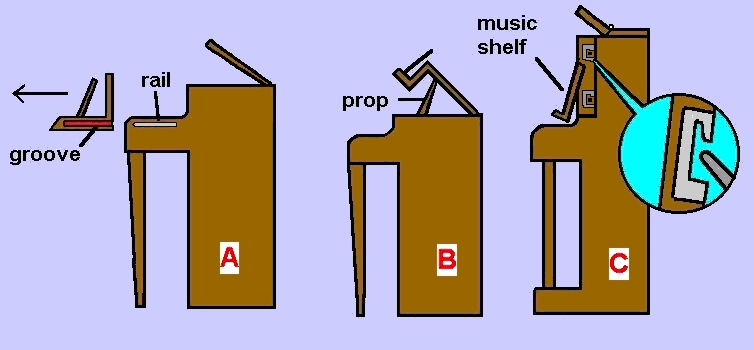
When piano manufacturers aren't actually busy manufacturing pianos, they're sitting around in little groups on the beach in the Caribbean smoking Cuban cigars, drinking cocktails with little umbrellas in them, and planning new, clever and difficult ways to put their piano cabinets together. They have not labored in vain. Over the years piano cabinet makers have shown remarkable inqenuity in obstructing and confusing anybody wishing to gain access to the inside of their pianos. Just opening the top lid will allow you to see the top of the action, of course....the hammers, dampers, tuning pins, etc. But if you need to remove dropped toys, pencils, paper clips and such from the tops of the keys, you will need to remove some cabinet parts. Sometimes this is obvious and easy, other times it takes Sherlock Holmes' older, smarter brother to figure where they've hidden the screws. In any case, should you ever want to look inside your vertical piano, just from curiosity or to retrieve something, below are three illustrations of some common cabinet constructions (to read about getting inside the bottom of vertical pianos, go to the link on fixing piano pedals to learn how to remove the "kickboard").

Illustration A shows a typical console or spinet case in which the music rack and cabinet front slide forward on a rail and groove arrangement. To remove it you will need to open the top, release any latches that secure the piece to the body of the piano, and slide it forward on the rail. Sometimes this piece is also connected to the fallboard (the piece that covers the keyboard) and both will slide off as a unit. A variation of this style has the front piece simply attached to the piano sides with wood screws instead of the rail, or perhaps setting on pins similar to illustration C. In these cases the piece should simply lift up and out once the screws are removed and/or the latches released.
Illustration B shows how some spinets have tops which lift up in one piece over the piano and cannot be removed without removing the hinges (the Baldwin Acrosonic and its clones used this style frequently). These lids are quite heavy and usually have a prop to hold them up. Do not let them fall on your fingers as it will definately slow down your ability to play trills. If no prop is provided, you'll have to move the piano out from the wall enough to let the lid rest securely open. With the lid up and the fallboard covering the keyboard, you will be able to see the ends of the keys and the action mechanism to retrieve all those playing cards somebody dropped in there. The fallboard on these pianos is a separate piece secured to the piano case by all sorts of ingenious mechanisms, but unless you intend to remove keys, it doesn't need to be removed.
The piano in drawing C is typical of full uprights in which the entire cabinet front, to which the music desk is attached, rests on pins set into the interior sides of the piano case. These fronts may simply lift off the pins and out (if the arrangement is as shown in the inset). Lift the top lid and look at the top and bottom corners of the front to see how it is secured. Old Victorian cabinet makers were especially creative. There may or may not be some sort of wooden or metal latchs that need to be released to free the pins. On some models, the front is attached to the sides of the case by blocks of wood with screws and will, of course, require a screwdriver to remove.
Be careful when the piano is equipped with a lever that causes the music rack to move forward when the fallboard is raised. Make certain the fallboard is down OVER the keys before you attempt to remove or replace the front. On Victorian uprights with lots of carvings, these front pieces can be quite heavy, so be prepared when you lift it out. With the front piece off you will be able to see the action, but not necessarily the keys. They may be hidden under the fallboard and top shelf, both of which are attached to the case with wood screws. Removing the fallboard is rarely necessary, but you may need to remove the top shelf to be able to reach objects dropped onto the ends of the keys. Usually this just involves taking out a few screws, or maybe combining a toad's tongue with bat hair in an iron cauldron.
If you're extremely bored and stuck home on a rainy day, you might wish to open the top of your piano and look around a bit. If you study things for awhile it will probably be fairly obvious how to remove cabinet parts to allow you to see the action, or fish out items dropped onto the backs of the keys (though certainly not necessarily convenient, and probably not without a flashlight and a couple of screwdrivers). You may very well find new and exciting ways your piano manufacturer has thought of to make getting into your piano an adventure.